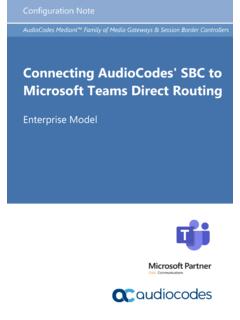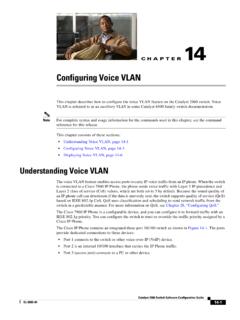Transcription of Configuring Static and Default Routes - Cisco
1 CHAPTER 25-1 Cisco ASA Series General Operations CLI Configuration Guide 25 Configuring Static and Default RoutesThis chapter describes how to configure Static and Default Routes on the ASA and includes the following sections: Information About Static and Default Routes , page 25-1 Licensing Requirements for Static and Default Routes , page 25-2 Guidelines and Limitations, page 25-2 Configuring Static and Default Routes , page 25-2 Monitoring a Static or Default route , page 25-6 Configuration Examples for Static or Default Routes , page 25-8 Feature History for Static and Default Routes , page 25-9 Information About Static and Default RoutesTo route traffic to a nonconnected host or network, you must define a Static route to the host or network or, at a minimum.
2 A Default route for any networks to which the ASA is not directly connected; for example, when there is a router between a network and the ASA. Without a Static or Default route defined, traffic to nonconnected hosts or networks generates the following syslog message: %ASA-6-110001: No route to dest_address from source_addressYou might want to use Static Routes in single context mode in the following cases: Your networks use a different router discovery protocol from EIGRP, RIP, or OSPF. Your network is small and you can easily manage Static Routes . You do not want the traffic or CPU overhead associated with routing simplest option is to configure a Default route to send all traffic to an upstream router, relying on the router to route the traffic for you.
3 However, in some cases the Default gateway might not be able to reach the destination network, so you must also configure more specific Static Routes . For example, if the Default gateway is outside, then the Default route cannot direct traffic to any inside networks that are not directly connected to the transparent firewall mode, for traffic that originates on the ASA and is destined for a nondirectly connected network, you need to configure either a Default route or Static Routes so the ASA knows out of which interface to send traffic. Traffic that originates on the ASA might include communications to a 25-2 Cisco ASA Series General Operations CLI Configuration Guide Chapter 25 Configuring Static and Default Routes Licensing Requirements for Static and Default Routessyslog server, Websense or N2H2 server, or AAA server.
4 If you have servers that cannot all be reached through a single Default route , then you must configure Static Routes . Additionally, the ASA supports up to three equal cost Routes on the same interface for load Requirements for Static and Default RoutesThe following table shows the licensing requirements for this feature:Guidelines and LimitationsThis section includes the guidelines and limitations for this Mode GuidelinesSupported in single and multiple context Mode GuidelinesSupported in routed and transparent firewall GuidelinesSupports GuidelinesSupports Stateful Failover of dynamic routing Guidelines IPv6 Static Routes are not supported in transparent mode in ASDM.
5 In clustering, Static route monitoring is only supported on the master unit. For information about clustering, see Chapter 8, Configuring a Cluster of ASAs. Configuring Static and Default RoutesThis section explains how to configure a Static route and a Static Default route and includes the following topics: Configuring a Static route , page 25-3 Configuring a Default Static route , page 25-4 Configuring IPv6 Default and Static Routes , page 25-5 ModelLicense RequirementAll modelsBase License. 25-3 Cisco ASA Series General Operations CLI Configuration Guide Chapter 25 Configuring Static and Default Routes Configuring Static and Default RoutesConfiguring a Static RouteStatic routing algorithms are basically table mappings established by the network administrator before the beginning of routing.
6 These mappings do not change unless the network administrator alters them. Algorithms that use Static Routes are simple to design and work well in environments where network traffic is relatively predictable and where network design is relatively simple. Because of this fact, Static routing systems cannot react to network Routes remain in the routing table even if the specified gateway becomes unavailable. If the specified gateway becomes unavailable, you need to remove the Static route from the routing table manually. However, Static Routes are removed from the routing table if the specified interface goes down, and are reinstated when the interface comes back you create a Static route with an administrative distance greater than the administrative distance of the routing protocol running on the ASA, then a route to the specified destination discovered by the routing protocol takes precedence over the Static route .
7 The Static route is used only if the dynamically discovered route is removed from the routing table. You can define up to three equal cost Routes to the same destination per interface. Equal-cost multi-path (ECMP) is not supported across multiple interfaces. With ECMP, the traffic is not necessarily divided evenly between the Routes ; traffic is distributed among the specified gateways based on an algorithm that hashes the source and destination IP addresses. To configure a Static route , see the following section: Adding or Editing a Static route , page 25-3 Adding or Editing a Static RouteTo add or edit a Static route , enter the following command:CommandPurposeroute if_name dest_ip mask gateway_ip [distance] Example:ciscoasa(config)# route outside [1] Enables you to add a Static dest_ip and mask arguments indicate the IP address for the destination network and the gateway_ip argument is the address of the next-hop router.
8 The addresses you specify for the Static route are the addresses that are in the packet before entering the ASA and performing distance argument is the administrative distance for the route . The Default is 1 if you do not specify a value. Administrative distance is a parameter used to compare Routes among different routing protocols. The Default administrative distance for Static Routes is 1, giving it precedence over Routes discovered by dynamic routing protocols but not directly connected Routes . The Default administrative distance for Routes discovered by OSPF is 110. If a Static route has the same administrative distance as a dynamic route , the Static route takes precedence.
9 Connected Routes always take precedence over Static or dynamically discovered Routes . 25-4 Cisco ASA Series General Operations CLI Configuration Guide Chapter 25 Configuring Static and Default Routes Configuring Static and Default RoutesExamplesThe following example shows Static Routes that are equal cost Routes that direct traffic to three different gateways on the outside interface. The ASA distributes the traffic among the specified (config)# route outside (config)# route outside (config)# route outside a Default Static RouteA Default route identifies the gateway IP address to which the ASA sends all IP packets for which it does not have a learned or Static route .
10 A Default Static route is simply a Static route with as the destination IP address. Routes that identify a specific destination take precedence over the Default Versions (1) and later, if you have two Default Routes configured on different interfaces that have different metrics, the connection to the ASA that is made from the higher metric interface fails, but connections to the ASA from the lower metric interface succeed as expected. You can define up to three equal cost Default route entries per device. Defining more than one equal cost Default route entry causes the traffic sent to the Default route to be distributed among the specified gateways.
















